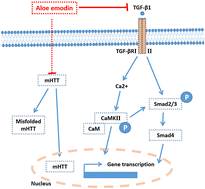Neuroprotective effect of aloe emodin against Huntington's disease-like symptoms in R6/1 transgenic mice†
Abstract
Aloe emodin is a natural anthraquinone derived from aloe or rhubarb, showing anti-renal fibrosis, anti-atherosclerosis and anti-cancer effects. Aloe emodin also shows neuroprotective effects in ischemic stroke rats. Naturally, anthraquinone derivatives generally have the effect of inhibiting the transforming growth factor-β1 (TGF-β1) pathway. There is an increase in the calcium/calmodulin-dependent protein kinase II (CaMKII) and TGF-β1 levels in both Huntington's disease (HD) patients’ brains and HD transgenic mice. Thus, we hypothesized that aloe emodin may inhibit the phosphorylation of CaMKII (p-CaMKII) and TGF-β1/sma- and mad-related protein (Smad) signaling in the brain, further preventing motor and cognitive dysfunction. Aloe emodin was orally administered to 10- to 20-week-old HD R6/1 transgenic mice. Aloe emodin improved the motor coordination of R6/1 transgenic mice in the rotarod test and attenuated visual recognition impairment in the novel object recognition test. Aloe emodin downregulated levels of the mutant huntingtin protein, p-CaMKII and TGF-β1, but not the TGF-β2 or TGF-β3 levels, in the brains of R6/1 mice. Aloe emodin could also inhibit neuronal apoptosis in the hippocampus of R6/1 mice. Altogether, these results indicated that aloe emodin prevents several HD-like symptoms through the inhibition of CaMKII/Smad and TGF-β1/Smad signaling in mice.



 Please wait while we load your content...
Please wait while we load your content...